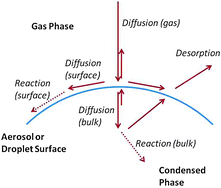Quantifying trace gas uptake to tropospheric aerosol: recent advances and remaining challenges†
Abstract
The interactions of trace gases with tropospheric aerosol can have significant effects on both gas phase and aerosol composition. In turn, this may affect the atmospheric oxidizing capacity, aerosol hygroscopicity and optical properties, and the lifetimes of trace aerosol species. Through the detailed description of specific reaction systems, this review article illustrates how detailed experimental studies of gas-particle interactions lead to both a comprehensive understanding of the underlying physical chemistry as well as accurate parameterizations for atmospheric modeling. The reaction systems studied illustrate the complexity in the field: (i) N2O5 uptake, presented as a benchmark multiphase system, can lead to both NOx loss and halogen activation, (ii) loss of HO2 on aqueous particles is surprisingly poorly studied given its potential importance for HOx loss, (iii) uptake of HNO3 by marine aerosol and heterogeneous oxidation of organic-bearing particles are examples of how gas-particle interactions can lead to substantial alteration of aerosol composition, and (iv) the uptake of glyoxal to ammonium sulfate aerosol leads to highly complex particle-phase chemistry. In addition, for the first time, this article presents the challenges that must be addressed in the design and interpretation of atmospheric gas-to-particle uptake experiments.

- This article is part of the themed collection: Atmospheric chemistry

 Please wait while we load your content...
Please wait while we load your content...